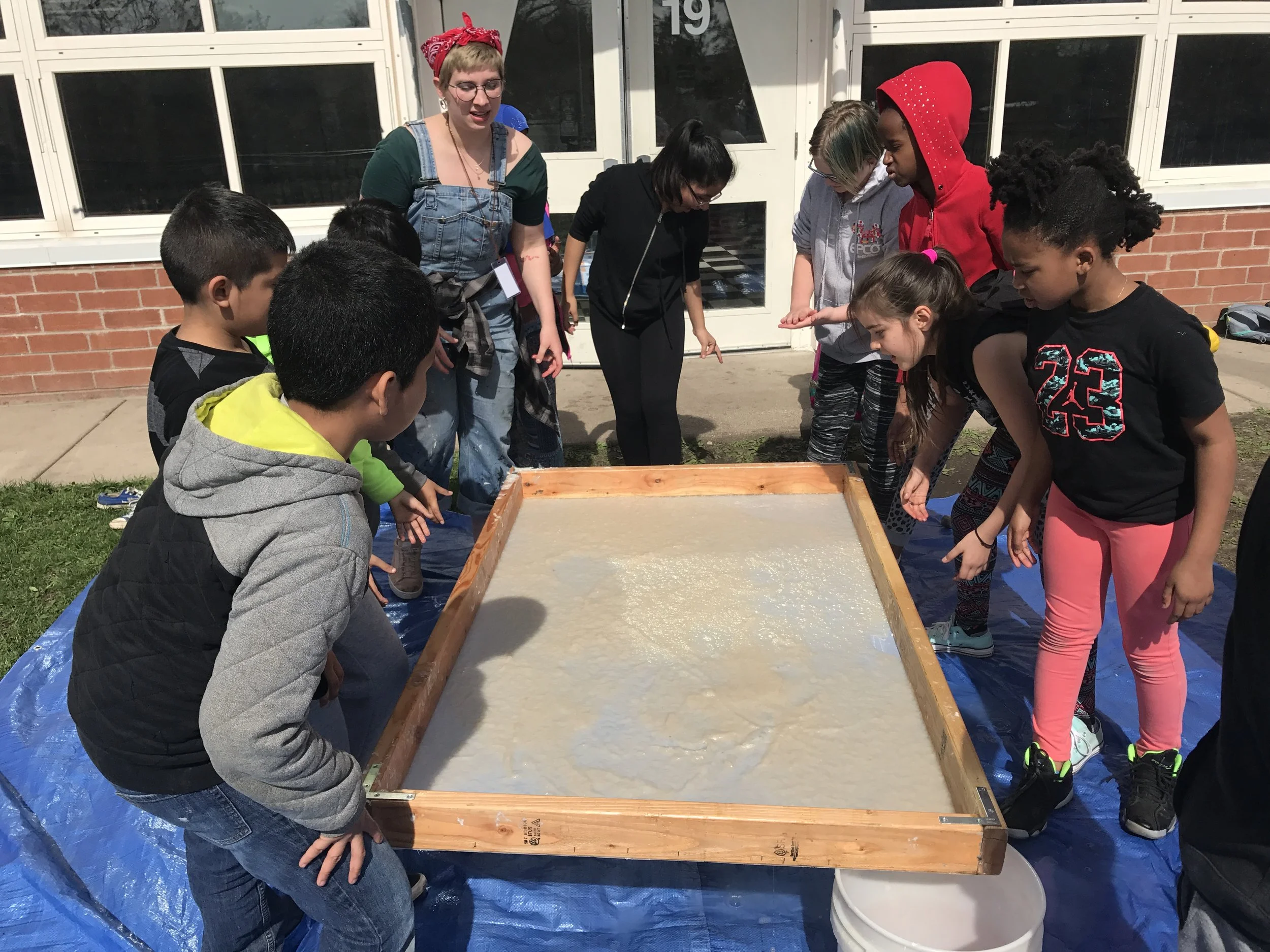Name of Project: Industrious, not Industrial Paper!
Grade Level or Age of Participant: 4th grade
School, Teacher and Classroom: Whittier School, Jane Swatosh
MCAD Teaching Artist: Nancy Hicks
Visual Arts Content or Standards
Grade 4-5, Artistic Foundations, 4.1.2.5.1
Standard: Demonstrate knowledge and use of the technical skills of the art form, integrating technology when applicable.
Benchmark: 1. Describe the tools, materials and techniques used in a variety of two- and three-dimensional media such as drawing, printmaking, ceramics or sculpture.
Grade 4-5, Artistic Foundations, 4.1.3.5.1
Standard: Demonstrate understanding of the personal, social, cultural and historical contexts that influence the arts areas.
Benchmark: Describe the personal, social, cultural, or historical contexts that influence the creation of visual artworks, including the contributions of Minnesota American Indian tribes and communities.
Curricular Link / Standards (if in a classroom only)
4th Grade, 4.3.4.1.1
Standard: In order to maintain and improve their existence, humans interact with and influence Earth systems.
Benchmark: Describe how the methods people utilize to obtain and use water in their homes and communities can affect water supply and quality.
Overview of Project
Lead a discussion with the students about the history of papermaking, the creation of paper, and the importance of recycling. Papermaking uses a lot of water, and the paper industry creates a lot of air and water pollution. From here, we will move into creating a large sheet of paper as a group. When it is dry, we will discuss ways to reduce the overuse of paper and ways to recycle or reuse paper—along with the issue of the overuse of water.
“Big Ideas”/ Essential QUESTION(s)
How do we use or overuse materials in our lives?
How can we reduce or reuse materials use to lessen impact on the environment, expense and pollution?
What is the larger effect of our actions on the world
Student Outcome Objectives
1. Students will listen, consider, and discuss how traditional paper making techniques and handmade paper process employ the water cycle and water waste.
2. Students will observe what a paper mill looks like and the industrial waste, pollution and deforestation it creates.
3. Students will consider and share ways to create less paper waste.
4. Students will make a large sheet of paper by applying traditional paper making techniques.
Prior Knowledge
The students will have discussed pollution, the water cycle, the importance to reduce, reuse, and recycle in their science unit.
Examples of Artwork
Variety of handmade paper samples/ Prompt the students to respond to the materials, ask about differences between the various samples and how they believe the paper might have been made.
Additional Resources
http://www.silk-road.com/artl/papermaking.shtml
https://en.wikipedia.org/wiki/Pulp_and_paper_industry
Assessment
The students will be working together to illustrate ideas of ways to subvert or reduce paper waste, if they actively discuss different ways to do this after an understanding of the paper process, the project will have been successful!
Materials
A pound of Abaca fiber, beaten
A large 3' x 4' paper mould
Plastic dropcloth
Weights for the dropcloth
Paper (for rough draft drawings)
Pencils, Pens, Markers
Learning Activities and Timing
Day 1.
1. Introduce the project, discussing the origins of paper, show the students different forms of paper (5 min).
2. Ask the students about how paper is made, talk a bit about it with them. (5 min).
3. Discuss the waste produced when creating paper (water, pollution, deforestation) and ask them about what they’ve learned about pollution and why it is negative. (5 min).
4. Tell them we will be making a big sheet of paper together, describe the process a bit (2 min).
5. Go outside with the class and create a large sheet of paper. Students assist pouring int he pulp, shaking the water from the mold and carefully filling in holes in the paper(20 min)
6. Let it dry in the sun outside or plan on getting it to a location it can dry for at least 2 days.
Day 2.
1. Review what we discussed the week before (5 min)
2. Prompt the students to discuss ways to cut back on paper waste (5 min)
3. Ask students to work together to create illustrations and drawings of ways to cut down on paper waste (as a rough draft) (15 min)
4. Have the students draw their illustrations on the large sheet of handmade paper (20 min)
Teaching Artist Reflection
Making a presentation that is mainly questions to create student discussion works well for this. Including many images/gifs on the papermaking process and bringing in exemplars of handmade paper is a good idea as well.
Make sure to have an alternative for students who do not want to get wet, the students will get wet in this process. (A good alternative is after the sheet is initially formed, propping it and having students work on filling in holes by pouring watered down pulp on spots with a cup!)















